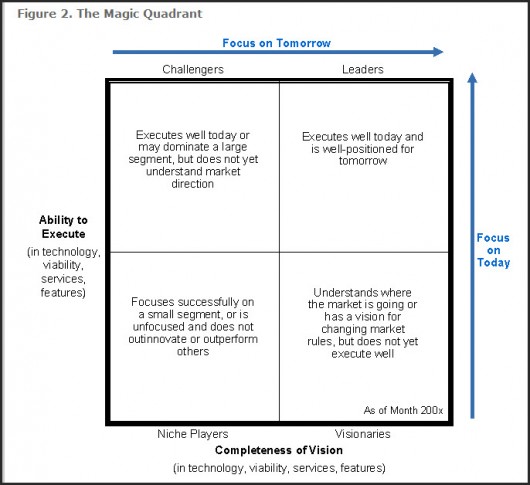Apple’s entry into the tablet computer market, the iSlate, has been getting a lot of attention the last couple of days, coinciding with annual Consumer Electronics Show in Las Vegas opening this week. So how will the iSlate and technology like it impact the tablet computer marketplace?
Turn to Gartner, a UST Libraries source for reports and analysis of the technology industry. In mid-December Gartner released a report, “Magic Quadrant for Mobile Enterprise Application Platforms.”
To find this report, log on to Gartner, search for “tablet,” and select the report from the list of results. Remember to capitalize your first and last names when logging in.
So what’s a Magic Quadrant? Essentially it’s a modified X Y graph on which are plotted the various vendors in a market relative to one another. Strategists will use this tool to determine what kind of technology to invest in, or which company to partner with for a particular venture. Business development will use this information to identify corporate prospects. (And of course students might use this information to target companies to work for.)
An illustration of a Magic Quadrant is below. In the case of tablet computers, companies like IBM, Apple, RIM, Microsoft, Oracle, and SAP will appear as points on a graph indicating their relative market position.

As you can see in this YouTube video, not everyone likes the Magic Quadrant. The questioner in the video says that it’s the most “reviled” in the industry. Gideon Gartner, the founder of Gartner Group, admits that it is “overused, misused, and abused.” Which only attests to the degree to which the Magic Quadrant has become embedded in the business of technology.
Contrary to appearances, Mr Gartner is not attacking anyone in this clip, though it may appear otherwise. It’s a Q&A session. Not daytime TV.
Links in this post:
Gizmodo’s Exhaustive Guide to the iSlate
Homepage of the Consumer Electronics Show
UST’s link to Gartner
Gartner’s guide to Magic Quadrants
YouTube video of Gideon Gartner on Magic Quadrants